Climate change has a profound impact on land degradation and desertification, particularly in drylands and semi-arid regions. The combination of higher temperatures, reduced rainfall, and increased weather variability is transforming fertile landscapes into barren ones. This process not only disrupts ecosystems but also endangers food security, biodiversity, and livelihoods, affecting billions of people worldwide.
Rising Temperatures and Evaporation
One of the most direct ways climate change accelerates desertification is through rising temperatures. Higher temperatures increase evaporation rates, which reduces soil moisture and stresses vegetation. In regions already prone to dry conditions, such as sub-Saharan Africa, the Middle East, and parts of Asia, the warming climate exacerbates water scarcity, making it harder for plants to survive. As vegetation declines, the soil becomes more vulnerable to erosion from wind and water, which accelerates land degradation.
Changing Rainfall Patterns
Climate change is also causing shifts in rainfall patterns. In some regions, there are longer dry spells, while others experience intense but irregular rainfall. Both patterns contribute to desertification. In prolonged droughts, plants struggle to thrive, leading to reduced ground cover. This exposes the soil to the elements and increases its susceptibility to erosion. In contrast, intense rainfall can lead to soil erosion and runoff, stripping away the fertile topsoil and further degrading the land.
Soil Degradation and Loss of Fertility
With vegetation cover decreasing, soils lose their natural protection. Degraded soils are often less capable of retaining water and nutrients, which is essential for plant growth. This degradation creates a feedback loop: as soil fertility declines, plants struggle to grow, and as plant cover diminishes, the soil becomes even more exposed to degradation. In addition to nutrient depletion, processes like salinization—often linked to improper irrigation—exacerbate soil degradation, further advancing desertification.
Impacts on Agriculture and Food Security
Desertification poses a severe threat to agriculture and food security, particularly in regions that rely heavily on rain-fed agriculture. As land becomes less productive, yields decline, leading to food shortages and increased dependence on imports. This trend particularly affects low-income countries, where agriculture is a primary source of income. In addition, degraded land requires more inputs, such as water and fertilizers, to maintain productivity, which increases costs for farmers and can push them further into poverty.
Biodiversity Loss and Ecosystem Disruption
As deserts expand, biodiversity is impacted. Plant and animal species adapted to specific climates and habitats may struggle to survive in hotter, drier conditions. Many plants that thrive in drylands are well adapted to scarce water, but as water availability decreases, these ecosystems face the risk of collapse. Loss of plant diversity can disrupt the entire ecosystem, affecting species that rely on these plants for food and shelter. For example, herbivores may lose their primary food sources, and predators dependent on these herbivores may also be impacted, creating a cascade effect across the ecosystem.
Social and Economic Consequences
The human impact of desertification is significant. Communities in affected regions often face loss of livelihoods, as agricultural productivity declines. This decline contributes to economic instability, poverty, and even displacement or migration, as people move in search of better living conditions. The UN has identified desertification as a driver of forced migration, particularly in sub-Saharan Africa and Central Asia, where entire communities are forced to abandon their degraded land.
Mitigation and Adaptation Strategies
Mitigating the impact of climate change on desertification requires a combination of adaptation and prevention strategies. Sustainable land management practices, such as agroforestry, soil conservation, and efficient water management, can help restore degraded land. Reforestation and afforestation projects are also crucial, as they enhance soil quality, retain water, and provide habitats for biodiversity. Additionally, policies supporting sustainable land use and climate resilience, including incentives for farmers to adopt sustainable practices, play an essential role.
conclusion
climate change significantly accelerates desertification and land degradation, especially in vulnerable regions. Addressing this issue requires coordinated efforts to mitigate climate impacts and implement sustainable land management practices. By taking action now, we can work toward preventing further desertification and protecting the livelihoods of those who depend on the land for their survival.








Leave a Comment